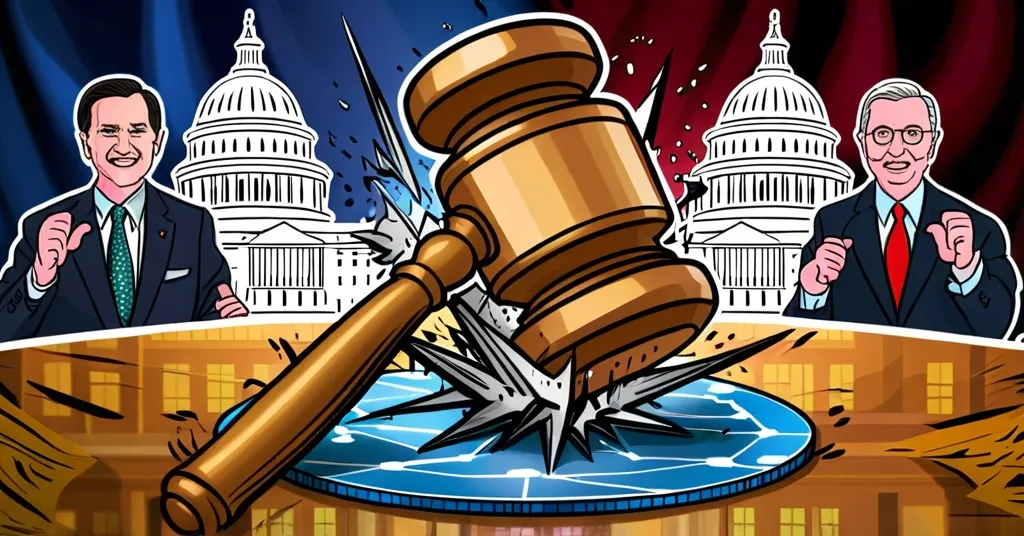U.S. Lawmakers Launch Bicameral Group to Fast-Track Crypto Regulation in 100 Days

Republican Lawmakers Launch Bicameral Working Group to Fast-Track Crypto Regulation
Is the U.S. on the brink of a regulatory revolution for cryptocurrencies? Republican lawmakers have formed a bicameral working group to accelerate the regulation of the crypto industry, focusing on stablecoins and digital asset market structures.
- Bipartisan effort to clarify crypto regulations
- Emphasis on stablecoins and market structures
- Aims to push bills through within 100 days
Legislative Actions
On February 4, a significant move was made on Capitol Hill to bring clarity to the cryptocurrency industry. A bicameral working group, involving both the House and Senate, was launched by Representatives French Hill and Glenn Thompson, along with Senators Tim Scott and John Boozman. This initiative spans four key committees: House Financial Services, House Agriculture, Senate Banking, and Senate Agriculture, showcasing a bipartisan commitment to tackling the regulatory gray area that has long defined the crypto space.
The group is building on the Financial Innovation and Technology for the 21st Century Act (FIT21), a bill that has already passed the House, and will be complemented by a new stablecoin bill introduced by Senator Bill Hagerty. Senate Banking Chair Tim Scott has set an ambitious timeline, aiming to push these crypto bills through the Senate within the first 100 days of the congressional session. This speed is crucial, as Scott stated, “We need to act quickly to bring clarity and structure to the crypto industry.”
Executive Orders
This legislative push aligns with recent executive actions taken by Trump, who on January 23 issued an order laying the groundwork for a government-held Bitcoin reserve and directives against a central bank digital currency (CBDC). These moves signal a strategic alignment between legislative and executive branches, aiming to create a more favorable environment for digital assets in the U.S.
Industry Impact
The crypto industry has long been vocal about the need for regulatory clarity, often citing the lack of defined rules as a reason for moving operations overseas. If successful, the bicameral working group’s efforts could encourage crypto firms to return to the U.S. and operate within a well-defined regulatory framework. David Sacks, Trump’s crypto and AI czar, envisions a “golden age” for crypto in the U.S., emphasizing the potential to foster innovation and keep digital asset operations onshore.
However, the industry is no stranger to hype and overpromise. While regulation is a step in the right direction, it’s not a silver bullet. The industry will still face challenges, from market volatility to security concerns, and the regulatory framework must be robust enough to address these without stifling innovation. The devil, as always, is in the details, and the true impact of these regulations will only be clear once they’re in action.
Challenges and Counterpoints
While the optimism from figures like David Sacks is encouraging, some crypto advocates remain skeptical, fearing that overregulation could stifle the very innovation that makes the industry thrive. There’s also the concern that increased compliance costs might drive smaller players out of the market. Critics argue that the U.S. should take a more hands-off approach, allowing the industry to self-regulate as it has done historically.
Moreover, while the focus on stablecoins and market structures is necessary, it’s crucial to consider the broader implications on privacy and decentralization, core tenets of the crypto ethos. Regulations that are too heavy-handed could undermine these principles, potentially driving users to less regulated jurisdictions.
Effective Accelerationism
From an effective accelerationism perspective, these regulations could potentially accelerate the adoption of cryptocurrencies in the U.S. by providing a clear framework. A well-defined regulatory environment could attract more institutional investors, leading to greater mainstream adoption and integration of digital assets into the financial system. However, this acceleration must be balanced with preserving the innovative spirit and decentralized nature of cryptocurrencies.
Key Questions and Takeaways
- What is the purpose of the bicameral working group?
The purpose is to fast-track crypto regulations, focusing on stablecoins and digital asset market structures, to provide clarity to the crypto industry.
- Who are the key figures leading this initiative?
Representatives French Hill and Glenn Thompson, along with Senators Tim Scott and John Boozman, are leading the initiative.
- What existing legislation is the working group building upon?
The working group is building upon the Financial Innovation and Technology for the 21st Century Act (FIT21) and a new stablecoin bill introduced by Senator Bill Hagerty.
- What is the timeline for pushing the crypto bills through the Senate?
Senate Banking Chair Tim Scott aims to push the crypto bills through within the first 100 days of the congressional session.
- What broader vision was mentioned by David Sacks?
David Sacks envisions a “golden age” for crypto in the U.S., emphasizing the importance of the current moment for digital assets.
- What executive actions were taken by Trump related to crypto?
Trump issued an executive order on January 23 laying the groundwork for a government-held Bitcoin reserve and directives against a central bank digital currency.
- How might the working group impact the crypto industry?
If successful, the working group could provide the long-awaited clarity needed to encourage crypto firms to return to the U.S. and operate within a defined regulatory framework.
- What are the potential challenges of these regulations?
Challenges include increased compliance costs, potential stifling of innovation, and concerns about privacy and decentralization.
- How might these regulations align with effective accelerationism?
They could accelerate crypto adoption by providing a clear framework, attracting more institutional investment, but must balance this with preserving the industry’s innovative spirit.
The road ahead for crypto regulation in the United States is paved with both opportunity and caution. As we look to embrace the potential of digital assets, it’s crucial to remember that while decentralization and innovation are at the heart of the crypto revolution, the path to mainstream adoption requires a balanced approach to regulation. With influential figures like David Sacks championing the cause, the stage is set for the U.S. to lead in the global crypto landscape. But only time will tell if the regulatory framework can keep pace with the industry’s rapid evolution.
As we navigate this regulatory landscape, let’s keep our eyes on the prize: a future where cryptocurrencies can thrive while maintaining the core principles of privacy, decentralization, and innovation that drew many of us to this space in the first place. And hey, if we can do it with a bit less hype and a bit more substance, all the better.



